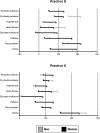The potential of electronic medical record systems to support quality improvement work and research in Norwegian general practice
- PMID: 12793909
- PMCID: PMC161825
- DOI: 10.1186/1472-6963-3-10
The potential of electronic medical record systems to support quality improvement work and research in Norwegian general practice
Abstract
Background: Electronic medical record (EMR) systems are used for many purposes including patient care, administration, research, quality improvement and reimbursement. This study aimed to test a data extraction tool (QTools) and to provide information to support the interpretation of EMR data.
Methods: Comparison of aggregated practice data for selected EMR fields and interviews with practice staff. Practices received summaries of their data and aggregated data for other practices. Summaries were discussed in interviews.
Results: Fourteen general practices in the Oslo area using the Winmed EMR participated. QTools ran successfully at all 14 practices. Nine practices agreed to interviews. Apart from age and sex, general patient information was poorly recorded. Face-to-face consultations account for 59% of contacts but differences in coding led to variations between practices. Psychiatric problems accounted for 13% of diagnoses, other diagnosis groups rarely accounted for more than 5%. Over 90% of diabetics and 75% of patients with heart disease were identified by diagnosis code alone.
Conclusion: Some variation seen in EMR data is due to differences in the way staff use their EMR. These data can support quality improvement work but this requires an awareness of how the EMR is actually used by practice staff.
Figures

Similar articles
-
A new quality improvement study every day? Using QTools to build quality improvement projects around primary care electronic medical record systems.Stud Health Technol Inform. 2004;107(Pt 2):1106-9. Stud Health Technol Inform. 2004. PMID: 15360984
-
[Routine data from general practitioner's software systems - Export, analysis and preparation for research].Gesundheitswesen. 2010 Jun;72(6):323-31. doi: 10.1055/s-0030-1249689. Epub 2010 May 20. Gesundheitswesen. 2010. PMID: 20491004 German.
-
Physicians use EMR to improve quality. Esse Health takes lead in primary care technology, quality.Med Group Manage J. 1999 Nov-Dec;46(6):18-21, 24-7. Med Group Manage J. 1999. PMID: 10662470
-
[Detailed data collection regarding the utilization of medical services, morbidity, course of illness and outcomes by episode-based documentation in general practices within the CONTENT project].Gesundheitswesen. 2007 May;69(5):284-91. doi: 10.1055/s-2007-976517. Gesundheitswesen. 2007. PMID: 17582545 Review. German.
-
The genome-enabled electronic medical record.J Biomed Inform. 2007 Feb;40(1):44-6. doi: 10.1016/j.jbi.2006.02.010. Epub 2006 Mar 15. J Biomed Inform. 2007. PMID: 16616698 Review.
Cited by
-
Reliability of information on people with disabilities gathered by community health workers in highly consanguineous communities of Northeastern Brazil.BMC Health Serv Res. 2017 May 2;17(1):317. doi: 10.1186/s12913-017-2267-3. BMC Health Serv Res. 2017. PMID: 28464869 Free PMC article.
-
Computerized extraction of information on the quality of diabetes care from free text in electronic patient records of general practitioners.J Am Med Inform Assoc. 2007 May-Jun;14(3):349-54. doi: 10.1197/jamia.M2128. Epub 2007 Feb 28. J Am Med Inform Assoc. 2007. PMID: 17329733 Free PMC article.
-
Using Machine Learning and Natural Language Processing Algorithms to Automate the Evaluation of Clinical Decision Support in Electronic Medical Record Systems.EGEMS (Wash DC). 2016 Aug 10;4(3):1222. doi: 10.13063/2327-9214.1222. eCollection 2016. EGEMS (Wash DC). 2016. PMID: 27683664 Free PMC article.
-
Implementing standardized provider documentation in a tertiary epilepsy clinic.Neurology. 2020 Jul 14;95(2):e213-e223. doi: 10.1212/WNL.0000000000009778. Epub 2020 Jun 16. Neurology. 2020. PMID: 32546650 Free PMC article.
-
Association of chromosome 9p21 SNPs with cardiovascular phenotypes in morbid obesity using electronic health record data.Genomic Med. 2008 Jan;2(1-2):33-43. doi: 10.1007/s11568-008-9023-z. Epub 2008 Jul 26. Genomic Med. 2008. PMID: 18716918 Free PMC article.
References
-
- Grimsmo A, Grimstad SA, Lilleholt O, Snoen SE, Storset B. Informasjon til planlegging og sammenlikning i kommunene. Bruk av data fra EDB-journalen i allmennpraksis. [Information for planning and comparison in the municipalities. Use of data from electronic medical record systems in general practice] Tidsskr Nor Lægeforen. 1994;114:1977–1982. - PubMed
-
- Ministry of Health and Social Affairs. Elektronisk pasientjournal standardisering. Arkitektur, arkivering og sikkerhet. [Electronic medical record system standardisation Architecture, archiving and security] Oslo; Green paper version 07. 2000.
Publication types
MeSH terms
LinkOut - more resources
Full Text Sources
Medical
Miscellaneous

